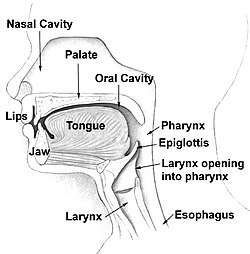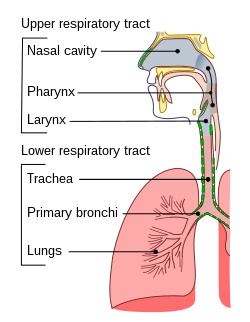Nasal cavities
| Nasal Cavity | |
|---|---|

Head and neck.
|
|

Conducting passages
|
|
| Details | |
| Identifiers | |
| Latin | cavum nasi; cavitas nasi |
| MeSH | A04.531.449 |
| TA | A06.1.02.001 |
| FMA | 54378 |
|
Anatomical terminology
[]
|
|
The nasal cavity (or nasal fossa) is a large air filled space above and behind the nose in the middle of the face. Each cavity is the continuation of one of the two nostrils.
The term "nasal cavity" can refer to each of the two sides of the nose or to the two sides combined. The two nasal cavities condition the air to be received by the other areas of the respiratory tract. Owing to the large surface area provided by the nasal conchae (also known as turbinates), the air passing through the nasal cavity is warmed or cooled to within 1 degree of body temperature. In addition, the air is humidified, and dust and other particulate matter is removed by vibrissae, short, thick hairs, present in the vestibule. The entire mucosa of the nasal fossae is covered by a blanket of mucus, which lies superficial to the microscopic cilia and also filters inspired air. The cilia of the respiratory epithelium move the secreted mucus and particulate matter posteriorly towards the pharynx where it passes into the esophagus and is digested in the stomach. The nasal cavity also houses our sense of smell and contributes greatly to taste sensation through its posterior communication with the mouth via the choanae.
The lateral wall of each nasal cavity mainly consists of the maxilla. However, there is a deficiency that is compensated by the perpendicular plate of the palatine bone, the medial pterygoid plate, the labyrinth of ethmoid and the inferior concha. The paranasal sinuses are connected to the nasal cavity through small orifices called ostia. Most of these ostia communicate with the nose through the lateral nasal wall, via a semi-lunar depression in it known as the infundibulum. The infundibulum is bound laterally by a projection known as the uncinate process.
...
Wikipedia
